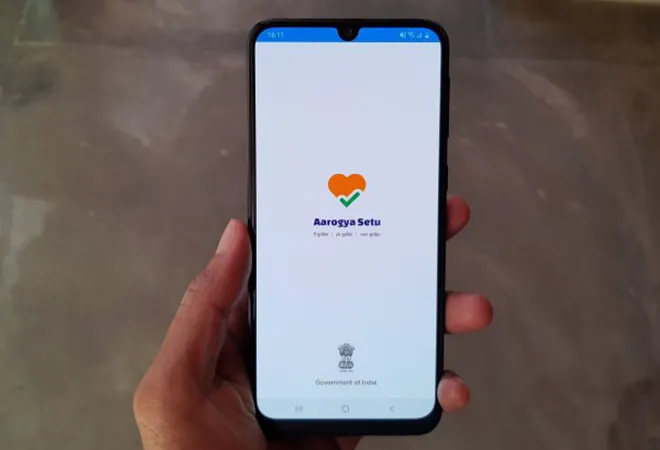-
CENTRES
Progammes & Centres
Location
The success of the application is reliant on two factors — its own technical implementation, along with the uptake among the population at large.

The COVID-19 outbreak has seen unprecedented government measures to protect lives, ranging from strict lockdowns to closure of borders in the Schengen area. Even as questions reign on the economic impacts of the lockdown, it is certainly preferable to widespread deaths, with vaccines and approved vaccinations still being months away by the most optimistic estimates. Nonetheless, as many countries demonstrate, it is essential to plan towards bringing life to a modicum of normalcy. As countries look for exit strategies to lift the lockdown, there is a need for accurate information to strike the right balance between relaxing restrictions and preventing a second wave of infections. In this regard, smartphone-based contact tracing apps are being widely adopted by countries, to prevent potential infections among health workers, who’d otherwise have to manually engage in contact tracing.
Countries like South Korea who successfully managed to flatten the curve even without imposing a lockdown did so by tracking the movement of infected people through GPS, surveillance camera records and credit card transactions, which were then used towards issuing real time alerts to the Korea Centres for Disease Control and Prevention. Singapore’s TraceTogether which launched on March 20 was another pioneer among contact tracing apps. UK’s National Health Service’s (NHS) COVID-19 app is designed to use people’s smartphones to keep track when they come close to an infected person by sending bluetooth signals. However, the app has only been introduced in the Isle of Wight as a pilot project and once successful will be mainstreamed.In view of such potential problems, Apple and Google have joined hands to develop a contact tracing app for users across the globe. The system will use the bluetooth of the phone to send alerts when one is in close proximity to a COVID-19 positive person for more than five minutes.
Amidst these efforts, India launched its contract tracing app, Aarogya Setu on 2 April to contain the spread by speeding up the process of identifying, testing and isolating people exposed to the virus before they spread it to others. The app uses a smartphone’s bluetooth and GPS systems to alert users when they come within six feet of COVID-19 patients. The alerts are generated by scanning through location-specific government databases. With the alerts, instructions on how to self-isolate and the course of action thereafter when one develops symptoms are sent, issued by the Ministry of Health and Family Welfare (MoHFW). While the app was not mandatory since its inception, the Government of India (GoI) made it mandatory for government and private sector employees during the third phase of the lockdown (w.e.f 4 May for a period of two weeks). Startups like Zomato also made the app mandatory for its employees.At the time of registration for the app, you are required to share personal data such as name, phone number, age, sex, profession, countries visited in the last 30 days and smoking habits. The collection of details such as the name runs counter to the principle of data minimisation, considering that information stored on the server will be hashed with a Unique Digital ID for each user. Equally, there remain questions about the liability of the government, with the GoI specifically disclaiming under the Terms of Service — “The Government of India specifically disclaims any implied warranties of fitness for a particular purpose or non-infringement. The functioning of the App is dependent on the compliance by all registered users of the App with these Terms. Accordingly, the Government of India disclaims all liability on account of such non-compliance by other registered users.”
The functioning of the app is therefore dependent on the compliance by all registered users of the app with these terms. Accordingly, the Government of India disclaims all liability on account of such non-compliance by other registered users. While seemingly logical, questions on personal or institutional liability, whether pertaining to misuse of data, or for misrepresentation within data submitted, remain unclear. Should the same be taken up by the judiciary in the middle of the crisis, it could constitute an otherwise perfectly avoidable blow to the government’s credibility in the midst of the pandemic.
The big question around bluetooth is how well it works to establish a contact and further if the system is reliable enough to gather proximity information. Typically, the range of bluetooth is much larger than that of social distancing, the latter of which is 1.5 meters. Bluetooth signals often pass through walls, in this case, it could unnecessarily flag people in two different rooms as “establishing contact.” The strength of the bluetooth largely largely depends on how people hold their phones; often the signals are strong when the phones are placed right to next to each other. The signal also depends on whether the phones are indoors or outdoors. This could generate false alerts. Aarogya Setu also fails to determine if people have been in contact for more than 5 minutes, unlike the application developed by Apple and Google. This could lead the app to send excessive alerts, despite the fact that not every contact is a transmission.
There are several apps introduced by state governments mainly to monitor the patients under quarantine as well as for the people to check for the nearest COVID19 patient. Tamil Nadu’s Quarantine Monitor was built by their e-Governance Agency, MahaKavach which is introduced by the Maharashtra State Innovation Society and the National Health Authority, COVA Punjab is a developed by the Government of Punjab. The governments of Goa and Puducherry in collaboration with a San Francisco-based startup Innovaccer has built the Test Yourself app while the Government of Kerala too has launched the GoK Direct Kerala app in partnership with Qkopy. The question that now comes up is – with the state governments already having their respective apps to monitor the movement, what additional value does Aarogya Setu provide?
A critical question that comes up with the lockdown being lifted in the coming weeks, will the Central government make the app mandatory for using public transport as well public spaces, as implemented in China? In this regard, how do we protect people who might not have a smart phone or the ability to install an app — a group that is likely to include older people, coincidentally also most vulnerable to the virus. At present, there are currently 298 million homes in the country, of which 197 million have a TV set. India has 502.2 million smartphone users as of December 2019 which constitutes to approximately 40% of the total population which also accounts for people owning more than one smartphone. While Aarogya Setu can only be downloaded on smartphones, this means that at least 60% of the population will not be able to do so. As of 6 May, 90 million people had already downloaded the app, constituting barely 7% of the total population despite mandating it for the government and private sector employees from 3 May. Everyone in a COVID-19 containment zone is also supposed to have the app. Such policymaking ignores gaping containment zones, such as the slums in Ahmedabad, where the access to smartphones will be understandably limited.
Studies by Oxford’s Big Data Institute says that the efficiency of a contract tracing app depends on the percentage of population that downloads it. The failure of government officials to address such pressing problems is a major issue, particularly when the people left out are potentially the most vulnerable. It is therefore imperative for the government to plug such implementation gaps before aiming for 100% penetration though the application. Contrary to the app introduced by the NHS, which outlines the measures to be undertaken for multiple possible scenarios on the contact/transmission axis, Aarogya Setu only gives two options to users — sample collected for testing or tested positive.
To this end, the government must prioritise protecting the vulnerable communities, and ensure that their current lack of a smartphone does not become a long-term hindrance. Furthermore, it must remember that good information sharing can only come with good testing, and the currently dismal rate of 1.042 tests per 1,000 needs to be ramped up significantly in order to prevent this application from becoming a white elephant potentially causing mass panic.
The views expressed above belong to the author(s). ORF research and analyses now available on Telegram! Click here to access our curated content — blogs, longforms and interviews.

Anushka Shah was Sub-Editor at ORF. Anushkas research interests include: climate finance urban environmental policy use of technology for socioeconomic development.
Read More +